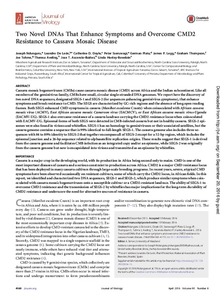| dc.contributor.author | Ndunguru, Joseph |
| dc.contributor.author | León, Leandro de |
| dc.contributor.author | Doyle, Catherine D. |
| dc.contributor.author | Sseruwagi, Peter |
| dc.contributor.author | Plata, German |
| dc.contributor.author | Legg, J.P. |
| dc.contributor.author | Thompson, Graham |
| dc.contributor.author | Tohme, Joseph M. |
| dc.contributor.author | Aveling, Theresa |
| dc.contributor.author | Ascencio Ibáñez, Jose T. |
| dc.contributor.author | Hanley Bowdoin, Linda |
| dc.date.accessioned | 2019-12-04T10:57:55Z |
| dc.date.available | 2019-12-04T10:57:55Z |
| dc.date.issued | 2016 |
| dc.identifier.citation | Ndunguru, Joseph; De León, Leandro; Doyle, Catherine D.; Sseruwagi, Peter; Plata, German; Legg, James P.; Thompson, Graham; Tohme, Joseph M.; Aveling, Theresa; Ascencio Ibáñez, Jose T.; Hanley Bowdoin, Linda. 2016. Two Novel DNAs that enhance symptoms and overcome CMD2 resistance to cassava mosaic disease . Journal of Virology 90(8): 4160-4173. |
| dc.identifier.issn | 0022-538x |
| dc.identifier.uri | https://hdl.handle.net/20.500.12478/871 |
| dc.description.abstract | Cassava mosaic begomoviruses (CMBs) cause cassava mosaic disease (CMD) across Africa and the Indian subcontinent. Like all members of the geminivirus family, CMBs have small, circular single-stranded DNA genomes. We report here the discovery of two novel DNA sequences, designated SEGS-1 and SEGS-2 (for sequences enhancing geminivirus symptoms), that enhance symptoms and break resistance to CMD. The SEGS are characterized by GC-rich regions and the absence of long open reading frames. Both SEGS enhanced CMD symptoms in cassava (Manihot esculenta Crantz) when coinoculated with African cassava mosaic virus (ACMV), East African cassava mosaic Cameroon virus (EACMCV), or East African cassava mosaic virus-Uganda (EACMV-UG). SEGS-1 also overcame resistance of a cassava landrace carrying the CMD2 resistance locus when coinoculated with EACMV-UG. Episomal forms of both SEGS were detected in CMB-infected cassava but not in healthy cassava. SEGS-2 episomes were also found in virions and whiteflies. SEGS-1 has no homology to geminiviruses or their associated satellites, but the cassava genome contains a sequence that is 99% identical to full-length SEGS-1. The cassava genome also includes three sequences with 84 to 89% identity to SEGS-2 that together encompass all of SEGS-2 except for a 52-bp region, which includes the episomal junction and a 26-bp sequence related to alphasatellite replication origins. These results suggest that SEGS-1 is derived from the cassava genome and facilitates CMB infection as an integrated copy and/or an episome, while SEGS-2 was originally from the cassava genome but now is encapsidated into virions and transmitted as an episome by whiteflies. |
| dc.description.abstract | Cassava mosaic begomoviruses (CMBs) cause cassava mosaic disease (CMD) across Africa and the Indian subcontinent. Like all members of the geminivirus family, CMBs have small, circular single-stranded DNA genomes. We report here the discovery of two novel DNA sequences, designated SEGS-1 and SEGS-2 (for sequences enhancing geminivirus symptoms), that enhance symptoms and break resistance to CMD. The SEGS are characterized by GC-rich regions and the absence of long open reading frames. Both SEGS enhanced CMD symptoms in cassava (Manihot esculenta Crantz) when coinoculated with African cassava mosaic virus (ACMV), East African cassava mosaic Cameroon virus (EACMCV), or East African cassava mosaic virus-Uganda (EACMV-UG). SEGS-1 also overcame resistance of a cassava landrace carrying the CMD2 resistance locus when coinoculated with EACMV-UG. Episomal forms of both SEGS were detected in CMB-infected cassava but not in healthy cassava. SEGS-2 episomes were also found in virions and whiteflies. SEGS-1 has no homology to geminiviruses or their associated satellites, but the cassava genome contains a sequence that is 99% identical to full-length SEGS-1. The cassava genome also includes three sequences with 84 to 89% identity to SEGS-2 that together encompass all of SEGS-2 except for a 52-bp region, which includes the episomal junction and a 26-bp sequence related to alphasatellite replication origins. These results suggest that SEGS-1 is derived from the cassava genome and facilitates CMB infection as an integrated copy and/or an episome, while SEGS-2 was originally from the cassava genome but now is encapsidated into virions and transmitted as an episome by whiteflies. |
| dc.format.extent | 90(8): 4160-4173 |
| dc.language.iso | en |
| dc.subject | Manihot Esculenta |
| dc.subject | African Cassava Mosaic Virus |
| dc.subject | Plant Diseases |
| dc.subject | Whiteflies |
| dc.subject | Disease Resistance |
| dc.subject | Genetic Resistance |
| dc.subject | Plant Breeding |
| dc.subject | Virus Del Mosaico De La Cassava |
| dc.subject | Enfermedades De Las Plantas |
| dc.subject | Resistencia A La Enfermedad |
| dc.subject | Resistencia Genética |
| dc.subject | Fitomejoramiento |
| dc.title | Two Novel DNAs that enhance symptoms and overcome CMD2 resistance to cassava mosaic disease |
| dc.type | Journal Article |
| dc.description.version | Peer Review |
| cg.coverage.region | Africa |
| cg.coverage.region | East Africa |
| cg.coverage.country | Tanzania |
| cg.creator.identifier | Joe Tohme: 0000-0003-2765-7101 |
| cg.isijournal | ISI Journal |
| cg.journal | Journal of Virology |
| cg.accessibilitystatus | Open Access |
| local.dspaceid | 75441 |
| cg.targetaudience | Scientists |
| cg.identifier.doi | https://dx.doi.org/10.1128/JVI.02834-15 |

